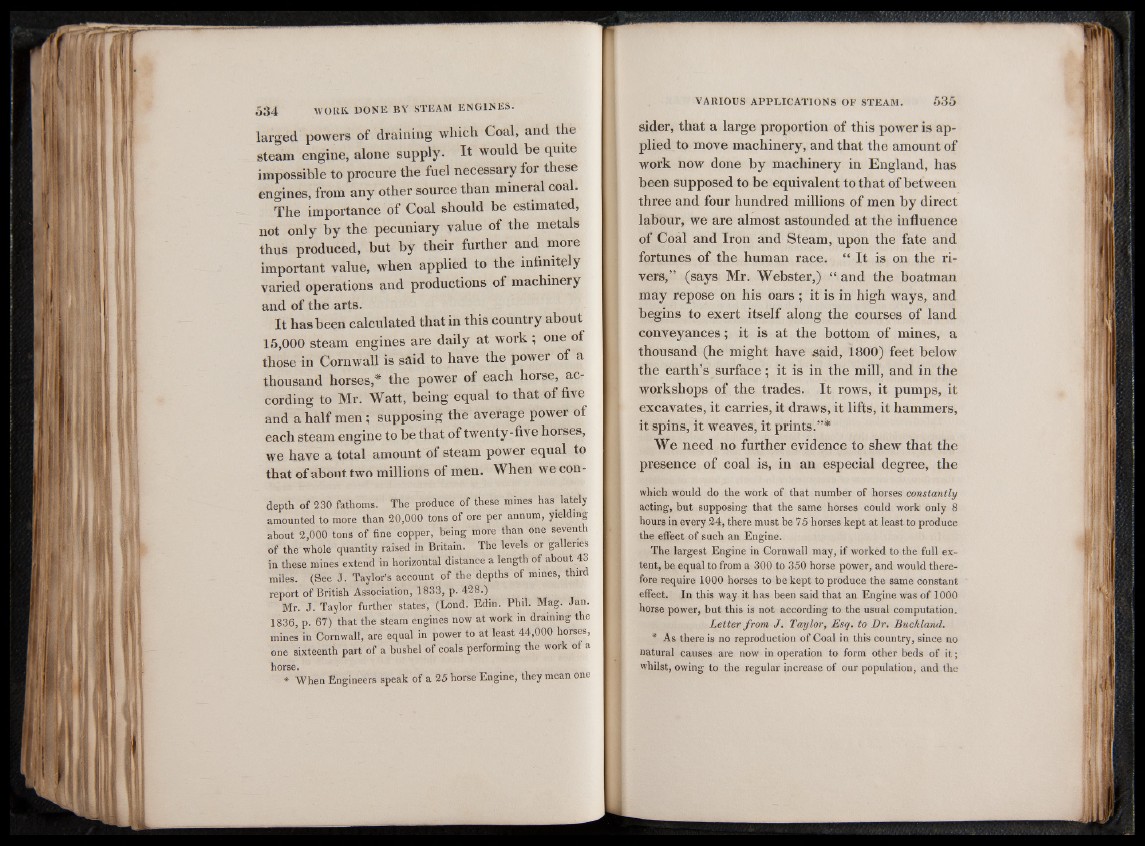
larged powers of draining which Coal, and the
steam engine, alone supply. It would be quite
impossible to procure the fuel necessary for these
engines, from any other source than mineral coal.
The importance of Coal should be estimated,
not only by the pecuniary value of the metals
thus produced, but by their further and more
important value, when applied to the infinitely
varied operations and productions of machinery
and of the arts.
It has been calculated that in this country about
15,000 steam engines are daily at work ; one of
those in Cornwall is said to have the power of a
thousand horses,* the power of each horse, according
to Mr. Watt, being equal to that of five
and a half men; supposing the average power of
each steam engine to be that of twenty-five horses,
we have a total amount of steam power equal to
that of about two millions of men. When we condepth
of 230 fathoms. The produce of these mines has lately
amounted to more than 20,000 tons of ore per annum, yielding
about 2,000 tons of fine copper, being more than one seventh
of the whole quantity raised in Britain. The levels or galleries
in these mines extend in horizontal distance a length of about 43
miles. (See J. Taylor’s account of the depths of mines, third
report of British Association, 1833, p. 428.)
Mr. J. Taylor further states, (Lond. Edin. Phil. Mag. Jan.
1836, p. 67) that the steam engines now at work in draining the
mines in Cornwall, are equal in power to at least 44,000 horses,
one sixteenth part of a bushel of coals performing the work of a
horse.
* When Engineers speak of a 25 horse Engine, they mean one
VARIOUS APPLICATIONS OF STEAM. 535
sider, that a large proportion of this power is applied
to move machinery, and that the amount of
work now done by machinery in England, has
been supposed to be equivalent to that of between
three and four hundred millions of men by direct
labour, we are almost astounded at the influence
of Coal and Iron and Steam, upon the fate and
fortunes of the human race. “ It is on the rivers,”
(says Mr. Webster,) “ and the boatman
may repose on his oars ; it is in high ways, and
begins to exert itself along the courses of land
conveyances; it is at the bottom of mines, a
thousand (he might have said, 1800) feet below
the earth’s surface; it is in the mill, and in the
workshops of the trades. It rows, it pumps, it
excavates, it carries, it draws, it lifts, it hammers,
it spins, it weaves, it prints.”*
We need no further evidence to shew that the
presence of coal is, in an especial degree, the
which would do the work of that number of horses constantly
acting, but supposing that the same horses could work only 8
hours in every 24, there must be 75 horses kept at least to produce
the effect of such an Engine.
The largest Engine in Cornwall may, if worked to the full extent,
be equal to from a 300 to 350 horse power, and would therefore
require 1000 horses to be kept to produce the same constant
effect. In this way it has been said that an Engine was of 1000
horse power, but this is not according to the usual computation.
Letter from J. Taylor, Esq. to Dr. Buckland.
* As there is no reproduction of Coal in this country, since no
natural causes are now in operation to form other beds of i t ;
whilst, owing to the regular increase of our population, and the